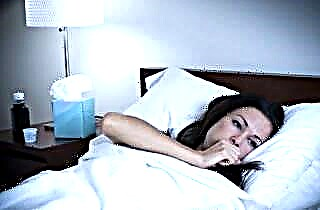 First you need to figure out what caused the hoarseness. To do this, you need to consult a doctor.
First you need to figure out what caused the hoarseness. To do this, you need to consult a doctor.
When a child has a hoarse voice, Komarovsky suggests starting treatment with an abundant alkaline drink and the use of local antiseptics. There are many pharmacy and home remedies, the use of which is indicated after establishing the cause of hoarseness.
The reasons may be as follows:
- overstrain of the vocal cords with prolonged screaming, crying, when the child can tear his voice. Quite often, schoolchildren can return from a singing lesson hoarse; stressful situations and fear;
- infectious infection when the focus of inflammation is located in the oropharynx and larynx (laryngitis, tonsillitis or tracheitis);
- damage to the mucous membrane by a foreign element, for example, crackers or husks from seeds;
- the ingress of small parts into the respiratory tract, which is a threat to the child's life;
- prolonged inhalation of dry or polluted air;
- allergic reactions, when Quincke's edema develops, the larynx is compressed by swollen tissues and breathing is difficult;
- age-related transformations of the voice in adolescence. The vocal cords are affected by hormonal influences, which is why boys often experience "breaking" of the voice. It usually occurs at 13-14 years of age and lasts for about six months. Teenagers may have bass or subtle squeals.
Each of these factors leads to the development of inflammation, swelling of the vocal cords and the appearance of hoarseness.
Rapid edema in children is predisposed by the abundant blood supply to the tissues of this area. To correctly interpret hoarseness, you need to pay attention to the accompanying symptoms. They can be presented:
- lacrimation;
- itchy eyes, skin;
- skin rashes;
- runny nose, nasal congestion;
- febrile hyperthermia;
- dry type cough ("barking");
- pain, sore throat;
- rapid fatigue;
- decreased appetite;
- an increase in closely located lymph nodes;
- severe sweating.
When is hoarseness extremely dangerous?
Depending on the reasons, a hoarse voice in a child may appear gradually or abruptly. Immediate medical attention is required in the following situations:
- ingress of a foreign element into the respiratory tract. The child may choke on a piece of meat, candy, small parts of a toy, or a button. In this case, the passage of air through the larynx is difficult and not enough oxygen is supplied to the lungs. The child's skin gradually acquires a bluish tint (ears, nose, fingers, lips), which indicates respiratory failure and hypoxia. In addition to hoarseness, paroxysmal coughing may disturb;
- allergic stenosis of the larynx after exposure to an allergen. If the child's immune system is hypersensitive to the exposed allergen, a powerful reaction develops. The rapid increase in swelling of the tissues of the neck and face leads to a decrease in the lumen of the airways, hoarseness and shortness of breath;
- croup. The true form and the false one can develop against the background of diphtheria, herpetic sore throat or measles. Clinically, the pathology is manifested by "barking" cough, hoarseness and noisy inhalation. Often, croup is typical for children 2-5 years old. It is extremely dangerous and life threatening.
Diagnostics
The child can be examined by a pediatrician, infectious disease specialist, ENT doctor or phoniatrist. If necessary, additional consultation with a neurologist and endocrinologist may be required.
 After questioning the complaints, an initial examination is carried out, during which the following can be identified:
After questioning the complaints, an initial examination is carried out, during which the following can be identified:
- redness of the pharyngeal wall;
- an increase in regional lymph nodes;
- hard breathing in the lungs, dry wheezing;
- pallor or cyanosis of the skin;
- skin rashes;
- swelling of the neck.
Laryngoscopy is also required, which allows you to establish the degree of narrowing of the larynx, assess the swelling of the mucous membrane and the presence of foreign elements.
For further examination, bacterial culture of material taken from the mucous membrane of the oropharynx and radiography of the lungs can be prescribed.
When diphtheria bacillus is detected, immediate excretion of antidiphtheria serum is required.
Therapeutic tactics
You can achieve good results in a short time, the main thing is to follow the recommendations:
- voice peace. It is forbidden to shout, speak loudly, only a short whisper is allowed;
- eliminate stress;
- regularly carry out wet cleaning and ventilate the nursery;
- humidify the air;
- exclude from the diet all mucous irritating dishes. This applies to spicy, salty, peppery, hard, hot and cold foods and drinks;
- plentiful alkaline drink. With laryngitis, warm milk with soda, still mineral water, compotes and tea are shown.
Drug therapy
For systemic action, the following can be prescribed: antibiotics; antiviral agents;
- antihistamines;
- antipyretic medicines;
- vitamins.
Local treatment can be carried out:
- rinsing solutions - Miramistin, Furacilin, Chlorophyllipt;
- throat sprays - Orasept, Tantum Verde, Ingalipt;
- lozenges for resorption - Lisobakt, Strepsils, Faringosept;
- solutions for lubricating the mucous membrane of the pharynx - Lugol.
Traditional treatment
 There are so many recipes based on milk and honey, and all because their therapeutic effect is confirmed from year to year:
There are so many recipes based on milk and honey, and all because their therapeutic effect is confirmed from year to year:
- a piece of butter and 5 g of honey can be added to warm milk with a volume of 230 ml, which reduces irritation of the mucous membrane and envelops it, preventing injury;
- you can add 1-2 g of soda, 1 drop of iodine to milk and drink it warm;
- honey in the form of a honeycomb can be given to a child to chew;
- 15 g of honey can be dissolved in warm water with a volume of 240 ml and rinsed with the solution twice a day.
Here are some recipes for making a mogul for kids:
- you need to take 2 eggs, chop it, separate the yolk and beat it in a blender. Then add 450 ml of warm milk and 50 g of honey. To interest the child with taste and aroma, you can add 30 ml of orange juice, only if you are not allergic to citrus fruits. Next, you need to slightly warm up the resulting mixture in a water bath and add egg white whipped with sugar until foam;
- Beat the yolk and 20 g of sugar, add 150 ml of hot milk, a small piece of butter and finely chopped clove of garlic. After mixing the mixture, you need to give the child 100 ml of water before bedtime;
- add butter, honey to the beaten yolk, and then grind thoroughly into a homogeneous mass. Then pour milk and add 2 g of soda. Give children to drink 100 ml in small sips;
- beat the egg yolk until foam is obtained, with a volume of twice the original, add a piece of butter, honey and a drop of iodine;
To avoid honey allergies in children, it is recommended to use acacia honey, which is hypoallergenic.
For oral administration, you can prepare the following medications:
- you can add a currant leaf to the rosehip broth, wait for the infusion to cool (5-7 minutes) and take 100-200 ml three times a day, after taking out the leaf;
- 5-7 rose hips will require 400 ml of boiling water. Having brewed the rosehip, you can add honey and give the child 50 ml every 2 hours;
- radish juice. For cooking, you need a root vegetable and honey. First, the radish is washed, the top is cut off and a depression is carefully made. It is filled with honey and left to infuse for 6-7 hours.Periodically, you can check how much juice is obtained. Children can be given 10 ml twice a day or even more often. As soon as the juice runs out, the honey is again placed in the depression and the next portion of the juice is waited for. Gradually, the root vegetable will begin to shrink and wrinkle. The volume of the juice also decreases, so you need to take a fresh radish.
You should rinse your oropharynx:
- warm solution, so as not to irritate the mucous membrane of the oropharynx;
- repeat the procedure every 1.5 hours, changing the types of drugs;
- gargle an hour after eating;
- after the procedure, it is forbidden to drink and eat for half an hour.
For rinsing, the following solutions can be used:
- soda-salt. To prepare it, you need to thoroughly dissolve 5 g of each ingredient in warm water with a volume of 280 ml, and then add a drop of iodine;
- chamomile, calendula, sage, yarrow or eucalyptus can be mixed in equal amounts, take 15 g and pour 320 ml of boiling water. In 15-25 minutes the infusion will be ready. After filtering, it can be used for rinsing.
Inhalation
With the advent of the nebulizer, the inhalation procedure has become much easier. The device has a number of advantages, therefore it can be used from infancy. The effect of inhalation is:
- facilitating the process of excretion of sputum;
- accelerating the regeneration of damaged tissues;
- elimination of mucosal irritation;
- reducing swelling and inflammation of the mucous membrane;
- reducing the severity of pain;
- restoration of the sonority of the voice.
 Before starting inhalation, consider:
Before starting inhalation, consider:
- the procedure is contraindicated in the presence of an allergy to the drug and a fever above 38 degrees;
- preparations for a nebulizer are diluted only with saline;
- a session requires 4 ml of solution, which is enough for 10 minutes of inhalation;
- after the procedure, it is not recommended to drink, eat and go out into the cold for 40 minutes;
- oil solutions and herbal decoctions are not used for the nebulizer.
Children can be inhaled through a nebulizer with still mineral water, saline, Ambroxol or Pulmicort.
If inhalation is carried out in the usual way ("over a saucepan"), you can prepare an herbal solution from calendula, oak bark or chamomile. You can also breathe over water with essential oils (fir, menthol, tea tree, or eucalyptus).
In order not to let the voice grow hoarse again, you need to strengthen the immunity of children from an early age. To do this, parents need to make every effort - control nutrition, sign up for sports activities, harden and relax with their child at sea. Trust me, this will be a solid foundation for childhood immunity.
Osip is the baby's voice? Are dry coughing fits disturbing the restful sleep of your son or daughter? What did the doctor prescribe? Is there a complex homeopathic preparation GOMEOVOX on the list of recommended ones? If yes, then, rest assured, soreness when breathing, swallowing, trying to speak, and coughing fits will begin to diminish after the first day of admission. In addition, GOMEOVOX has a minimum of contraindications and side effects.



